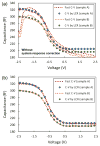Rapid and Accurate C-V Measurements
- PMID: 28579633
- PMCID: PMC5455788
- DOI: 10.1109/TED.2016.2598855
Rapid and Accurate C-V Measurements
Abstract
We report a new technique for the rapid measurement of full capacitance-voltage (C-V) characteristic curves. The displacement current from a 100 MHz applied sine-wave, which swings from accumulation to strong inversion, is digitized directly using an oscilloscope from the metal-oxide-semiconductor (MOS) capacitor under test. A C-V curve can be constructed directly from this data but is severely distorted due to non-ideal behavior of real measurement systems. The key advance of this work is to extract the system response function using the same measurement set-up and a known MOS capacitor. The system response correction to the measured C-V curve of the unknown MOS capacitor can then be done by simple deconvolution. No de-skewing and/or leakage current correction is necessary, making it a very simple and quick measurement. Excellent agreement between the new fast C-V method and C-V measured conventionally by an LCR meter is achieved. The total time required for measurement and analysis is approximately 2 seconds, which is limited by our equipment.
Keywords: C-V measurement; Capacitance measurement; Fast C-V measurement; MOS devices; Semiconductor device measurements; Transient measurement.
Figures








References
-
- Schroder DK. Semiconductor Material and Device Characterization. 3. Piscataway, NJ, USA: IEEE press; 2006.
-
- Veksler D, Bersuker G, Madan H, Vandelli L, Minakais M, Matthews K, Young CD, Datta S, Hobbs C, Kirsch PD. Multi-technique study of defect generation in high-k gate stacks. Proc IEEE IRPS. 2012 Apr;:5D.2.1–5D.2.5.
-
- Puzzilli G, Govoreanu B, Irrera F, Rosmeulen M, Van Houdt J. Characterization of charge trapping in SiO2/Al2O3 dielectric stacks by pulsed C-V technique. Microelectron Rel. 2007 Apr-May;47:508–512.
-
- Duan TL, Ang DS. Capacitance hysteresis in the high-k/metal gate-stack from pulsed measurement. IEEE Trans Electron Devices. 2013 Apr;60(4):1349–1354.
-
- Zhang WD, Zheng XF, Ruiz Aguado D, Rosmeulen M, Blomme P, Zhang JF, Van Houdt J. Two-pulse CV: A new method for characterizing electron traps in the bulk of SiO2/high-κ dielectric stacks. IEEE Electron Device Lett. 2008 Sep;29(9):1043–1046.
Grants and funding
LinkOut - more resources
Full Text Sources
Other Literature Sources
